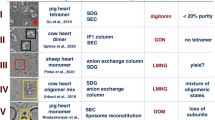Abstract
The permeability transition pore (PTP) is central for mitochondria function. PTP either open in low-conductance state to carry out mCICR (Ca2+-induced Ca2+ release from mitochondria) and play roles in cell phsyiological activities or open in high-conductance conformation to release harmful substances and play important roles in cell pathological responses and apoptosis. The results of study on the relationship between mCICR and PTP opening show Ca2+ concentrations but not the Ca2+ delivery mode determined the occurrence of mCICR or PTP opening. Ca2+-induced PTP opening began with and depended on mCICR. mCICR was a prerequisite for H2O2 and As2O3-induced PTP opening. The results indicated that the PTP opening was determined by Ca2+ stimulation intensity but not mode. PTP could switch from low- to high-conductance conformation and the PTP open by high-conductance began with low-conductance state. mCICR is necessary for Ca2+-dependent PTP opening. Our data suggested also that it would be possible to control cellular responses first by modulating mCICR, then by regulating PTP opening.
Similar content being viewed by others
References
Jouaville LS, Ichas F, Mazat J-P: Modulation of cell calcium signals by mitochondria. Mol Cell Chem 184: 371-376, 1998
Babcock DF, Herrington J, Goodwin PC, Park YB, Hille B: Mitochondrial participation in the intracellular Ca2+ network. J Cell Biol 136: 833-844, 1997
Ichas F, Jouaville LS, Sidash SS, Mazat J-P, Holmuhamedov EL: Mitochondrial calcium spiking: A transduction mechanism based on calciuminduced permeability transition involved in cell calcium signaling. FEBS Lett 348: 211-215, 1994
Ichas F, Jouaville LS, Mazat J-P: Mitochondria are excitable organelles capable of generating and conveying electrical and calcium signals. Cell 89: 1145-1153, 1997
Griffiths EJ, Halestrup AP: Protection by cyclosporin A of ischemia/reperfusion-induced damage in isolated rat hearts. J Mol Cell Cardiol 25: 1461-1469, 1993
Trost LC, Lemasters JJ: The mitochondrial permeability transition: A new pathophysiological mechanism for Reye's syndrome and toxic liver injury. J Pharmacol Exp Ther 278: 1000-1005, 1996
Schinder AF, Olson EC, Spitzer NC, Montal M: Mitochondria dysfunction is a primary event in glutamate neurotoxicity. J Neurosci 16: 6125-6133, 1996
Susin SA, Zamzami N, Kroemer G: Mitochondria as regulators of apoptosis: Doubt no more. Biochim Biophys Acta 1366: 151-165, 1998
Green DR, Reed JC: Mitochondria and apoptosis. Science 281: 1309-1312, 1998
Ichas F, Mazat J-P: From calcium signaling to cell death: Two conformations for the mitochondrial permeability transition pore. Switching from low-to high-conductance state. Biochim Biophys Acta 1366: 33-50, 1998
Gunter TE, Gunter KK, Sheu S-S, Garvin CE: Mitochondrial calcium transport: Physiological and pathological relevance. Am J Physiol 267: C313-C319, 1994
Jouaville LS, Ichas F, Mazat J-P: Modulation of cell calcium signals by mitochondria. Mol Cell Biochem 184: 371-376, 1998
Lemasters JJ, Nieminen A-L, Qian T, Trost LC, Elmore SP, Nishimura Y, Crowe RA, Cascio WE, Bradham CA, Brenner DA, Herman B: The mitochondrial permeability transition in cell death: A common mechanism in necrosis, apoptosis and autophagy. Biochim Biophys Acta 1366: 177-196, 1998
Zoratti M, Szabo I: The mitochondrial permeability transition. Biochim Biophys Acta 1241: 139-176, 1995
Broekemeier KM, Klocek CK, Pferfer DR: Proton selective substate of mitochondrial permeability pore: Regulation by the redox state of the electron transport chain. Biochemistry 37: 13059-13065, 1998
Frei B, Winterhalter KH, Richter C: Mechanism of alloxan-induced calcium release from liver mitochondria. J Biol Chem 260: 7394-740, 1985
Petronilli V, Szabo I, Zoratti M: The inner mitochondrial membrane contains ion conducting channels similar to those found in bacteria. FEBS Lett 259: 137-143, 1989
Emaus RK, Grunwald R, Lemasters JJ: Rhodamine123 as a probe of transmembrane potential in isolated rat-liver mitochondria: Spectral and metabolic properties. Biochim Biophys Acta 850: 436-448, 1986
Babcock DF, Hille B: Mitochondrial oversight of cellular Ca2+ signaling. Curr Opin Neurobiol 8: 398-404, 1998
Hoyt KR, Sharma TA, Reynolds I: Trifluoperazine and dibucaine-induced inhibition of glutamate-induced mitochondria depolarization in rat cultured forebrain neurons. Br J Pharmacol 122: 803-808, 1997
Larochette N, Decaudin D, Jacotot E, Brenner C, Marzo I, Susin SA, Zamzami N, **e Z, Reed J, Kroemer G: Arsenite induces apoptosis via a direct effect on the mitochondrial permeability transition pore. Exp Cell Res 249: 413-421, 1999
Kowaltowski AJ, Vercesi AE, Castilho RF: Mitochondrial membrane protein thiol reactivity with N-ethylmaleimide or mersalyl is modified by Ca2+: Correlation with mitochondrial permeability transition. Biochim Biophys Acta 1318: 395-402, 1997
Author information
Authors and Affiliations
Rights and permissions
About this article
Cite this article
Huang, X., Zhai, D. & Huang, Y. Study on the relationship between calcium-induced calcium release from mitochondria and PTP opening. Mol Cell Biochem 213, 29–35 (2000). https://doi.org/10.1023/A:1007138818124
Issue Date:
DOI: https://doi.org/10.1023/A:1007138818124




